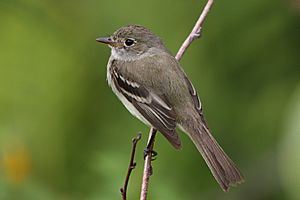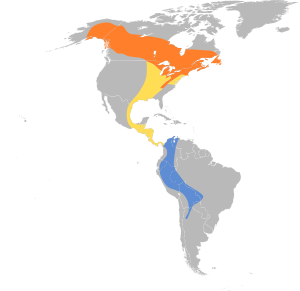Alder flycatcher facts for kids
Quick facts for kids Alder flycatcher |
|
|---|---|
 |
|
| Conservation status | |
| Scientific classification | |
| Genus: |
Empidonax
|
| Species: |
alnorum
|
 |
|
The alder flycatcher (Empidonax alnorum) is a small bird that eats insects. It belongs to the tyrant flycatcher family. The name Empidonax comes from Ancient Greek words meaning "gnat" and "master," because these birds are good at catching insects. The name alnorum is Latin and means "of the alders," referring to the trees they often live near.
Contents
What Does the Alder Flycatcher Look Like?
The alder flycatcher is one of the larger Empidonax species. It grows to be about 13–17 centimeters (5–7 inches) long and weighs 12–14 grams (about half an ounce). Its wings can spread 21–24 centimeters (8–9 inches) wide.
Its upper body is a dull greenish-olive color. The top of its head is a bit darker than its back. Its throat is white, and it has a darker band across its chest. Thin white rings go around its eyes. The bird has a wide bill. The lower part of its bill is pinkish or yellow-orange, and the upper part is black. Its wings are usually black with white bars. The edges of its inner wing feathers are also white. Young alder flycatchers have brownish upper parts, yellow underparts, and yellowish-brown wing bars.
The alder flycatcher looks a lot like other birds such as the eastern wood-pewee and the eastern phoebe. However, you can tell the alder flycatcher apart because it is smaller and often flicks its tail upwards.
Birds in the Empidonax group are known for being very hard to identify just by looking at them. Scientists sometimes use special tools like mist nets to catch them. Then they measure different body parts, like wings and beaks, to help figure out the exact species. Often, the best way to identify these birds in nature is by listening to their calls and songs.
How Are Alder Flycatchers Related to Other Birds?
The alder flycatcher is very closely related to the willow flycatcher (E. trailli). These two birds are called "sibling species" because they are so similar. For a long time, people thought they were the same species, called Traill's flycatcher. But in 1973, scientists noticed that their songs and the places they lived were different. This led them to realize they were actually two separate species. Later, genetic tests (looking at their DNA) confirmed this. A study of 12 Empidonax species showed that the alder and willow flycatchers are indeed each other's closest relatives.
Where Do Alder Flycatchers Live?
Alder flycatchers spend their summers breeding in most parts of Canada and Alaska. Their breeding range goes as far south as the northeastern United States. In the autumn, they fly south. They travel through the eastern United States, Mexico, and Central America. They spend their winters in the western parts of South America.
During the summer breeding season, alder flycatchers like to live in wet, thick bushes. These areas often have alder, maple, and birch trees. They prefer places that are not too high up, usually below 1,300 feet (about 400 meters). When they migrate, they can be found in both wet and dry places, including the edges of forests and open fields. In winter, they prefer scrubby areas or woodland edges, especially near water, and usually below 1,100 feet (about 335 meters).
Alder Flycatcher Behavior
What Sounds Do Alder Flycatchers Make?
The sounds the alder flycatcher makes are very helpful for identifying it. Its song is a clear "fee-bee-o." When they sing, these birds often throw their heads back and shake their tails.
Alder flycatchers make many different calls. The most common one is a "pit" sound, which they make when they are looking for food. They also have calls for when they are being aggressive or defending their territory, like "double-peak," "zwee-oo," and "wee-oo" calls. When they are excited, they might make a "kitter" call.
What Do Alder Flycatchers Eat?
The alder flycatcher mainly eats insects. These include sawflies, bees, wasps, ants, beetles, flies, butterflies, moths, locusts, grasshoppers, and crickets. They catch insects while flying or pick them off the leaves of trees. In the winter, some alder flycatchers will also eat fruit and seeds.
How Do Alder Flycatchers Reproduce?
Alder flycatchers build their nests in wet thickets of maple, alder, and birch trees. Their nests are usually low in bushes. They are shaped like a cup and are loosely built from plant materials. These materials include grass, weeds, pieces of bark, and small twigs. You can often see strips of grass or bark hanging from the bottom of the nest. The inside is lined with soft materials like plant fluff. The female bird does most of the nest building.
Male alder flycatchers sing to protect their breeding territory.
Females usually lay 3 or 4 eggs in each breeding season. The eggs are creamy-white or buff in color. They have dark speckles near the wider end. The female sits on the eggs to keep them warm for 12–14 days. When the chicks hatch, they are helpless and covered with tiny spots of olive-brown down. Both the male and female parents help care for the young birds. Young alder flycatchers take their first flight when they are about 13–14 days old.
Is the Alder Flycatcher Endangered?
The alder flycatcher is listed as a species of "least concern" by the IUCN Redlist. This means that its population is not currently in danger. The number of alder flycatchers in the United States is stable. However, their numbers in Canada went down by about 44% between 1966 and 2014. The species has a rating of 7 out of 20 on the Continental Concern Score. It is also considered a U.S.-Canada Stewardship species, meaning it's a bird that both countries work to protect.
See also
 In Spanish: Mosquero alisero para niños
In Spanish: Mosquero alisero para niños


